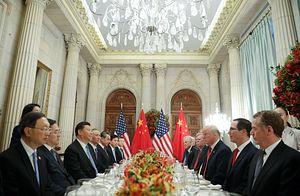This weekend, the 2019 iteration of the Shangri-La Dialogue (SLD), Asia’s premier security summit, kicks off in Singapore. While the SLD’s proceedings this year will again feature perspectives from officials and scholars alike on a wide range of security issues, one can expect the subject of heightening U.S.-China competition to dominate the headlines surrounding it given the regional and international attention to it in recent weeks.
The SLD itself usually sees a hive of activity at various levels, be it debates at the sessions themselves about state of the Asian security order or the numerous meetings on the sidelines that occur between officials as well as practitioners and experts. But each iteration is also an opportunity to take stock of the extent of continuity and change in the regional security environment as well as to assess which subjects are dominating the conversation. Last year, for instance, as I had observed before the start of SLD 2018, North Korea was a big focus, with the shift from saber-rattling to diplomacy between Washington and Pyongyang and the first, historic summit between U.S. President Donald Trump and North Korean leader Kim Jong un set to take place just after the conclusion of the SLD.
One of the recurring issues in focus at the SLD has tended to be the state of relations between the United States and China – often characterized by the cliché of being the world’s most important bilateral relationship. In recent years, there have been different manifestations of this at the SLD, be it heated exchanges between U.S. and Chinese perspectives on issues such as the South China Sea or fixations about what the level of Chinese representation says about Beijing’s perception of the SLD itself, as it seeks to engage in such forums and also develops its own institutions that include the Xiangshan Forum.
But this year in particular, the SLD will take place with the subject of heightened U.S.-China competition being front and center on the minds of participants and observers alike. While the headlines going into SLD 2019 has been focused on individual manifestations of this – be it the U.S. government’s actions on Huawei or a potential meeting between Trump and Chinese President Xi Jinping at the G-20 in Japan in June – the bigger picture is that, over the past year, increasing U.S.-China tensions, which date back to the 2010s, have been gradually concretizing into what increasingly looks for now like a longer-term U.S.-China competition as initially outlined in recent U.S. national security documents such as the National Security Strategy and the National Defense Strategy.
SLD 2019 will spotlight various dimensions of this. Optics-wise, the fact that China will be sending its defense minister to the SLD for the first time in nearly a decade, and that U.S. acting assistant secretary of defense Patrick Shanahan is expected to further outline the defense aspects of the U.S. Free and Open Indo-Pacific Strategy (FOIPS), will itself put the focus on the dynamics of U.S.-China relations this weekend. And irrespective of any efforts by both sides to manage aspects of this, whether it be in their remarks or through a reported pull aside meeting, the very fact that both officials are headlining each day of the SLD sets up an interesting one-two that will be sure to dominate the headlines.
Beyond this, U.S.-China competition can be expected to loom over other aspects of the SLD as well. As with previous iterations, addresses by other regional countries, and their responses to questions posed, will be notable to watch on this score to assess how they assess the U.S.-China competition variable within their own wider security outlooks. Among these will be the keynote address by Singapore Prime Minister Lee Hsien Loong, which comes at an interesting time amid Singapore’s commemoration of its bicentennial as well as a gradual ongoing leadership transition for the country away from Lee himself. Given Lee’s previous keynote address to the SLD in 2015 where he also dwelled on the subject of the changing balance of power, as well as his recent comments on Southeast Asia’s alignment choices, his remarks will be interesting to watch.
U.S.-China competition can also be expected to factor into other sessions of SLD 2019 as well, including plenary sessions on Korean security and the Asia’s evolving security order as well as the various special simultaneous special sessions, which this year include a focus on competition in the South Pacific as well as the security implications of regional infrastructure development given the visions articulated such as China’s Belt and Road Initiative (BRI) – testament to the intersection of security issues and other realms as well .
Of course, amid the expected focus on the U.S.-China relationship at this year’s SLD, there will no doubt be other interesting developments to watch as well. Issue-wise, for instance, each iteration of the SLD offers an opportunity to assess the evolving conversation on a number of staple security issues in Asia, including maritime security, cybersecurity, and confidence-building measures, and this year will be no different in that regard. And as with past SLDs, there will also be a few revelations offered by officials with respect to their own security approaches as well as their role in defense arrangements with other regional states as well. But given the state of play in the Asian security environment going into SLD 2019, it is a safe bet that U.S.-China competition will loom large over Asia’s premier security summit.

































